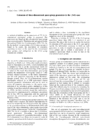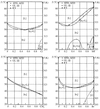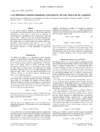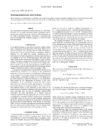issue contents
June 1999 issue

Cover illustration: Simulated diffraction pattern for a two-dimensionally disordered decasil (porous SiO2) calculated using a fast recursive algorithm. The plane is perpendicular to c with the reciprocal index l = 1; the error probability is 0.5 and the intensities are scaled to 25% of the highest value. Courtesy of Peter Daniels.
research papers
A procedure for quantitative estimation of crystalline/amorphous phases in ceramics is described. The method does not require calibration data for use as an internal/external standard.
A theoretical model, based on a ray-tracing method, has been developed to take into account the effect of curvature of cylindrical samples on the X-ray diffraction peak intensities. Texture analysis of zircaloy-4 tubes (9.5 mm diameter) confirms the validity of the model.
A reliable and relatively inexpensive kappa goniometer has been constructed to perform texture and residual-stress analysis in both Ω and χ configurations. Validation has been achieved by checking the setting precision and the assembly reliability for the two types of configuration.
A twin structure in chalcogenides characterized by a tetragonal unit cell, lattice-parameter ratio c/a = 2 and twin-habit plane {102} is identified by electron microdiffraction at a transmission electron microscope. The analysis represents a method to analyse unambiguously electron diffraction patterns for reliable electron crystallography in nanoscopic volumes.
A new method for the determination of the orientation distribution function (ODF) from individual orientations is proposed.
A new real-space approach to the X-ray phase problem is applied to solve a disordered structure of a three-dimensional coordination polymer.
A robust algorithm is described for the determination of symmetries in an atomic configuration.
The structure of the μ-Al4Mn phase is interpreted as a modulated crystal structure. The modulation is considered to be due to the rearrangement of atomic vacancies as a response to the occurrence of charge-density waves.
K2(NbO)2Si4O12 satisfies the structural criteria for ferroelectricity and has an estimated Curie temperature higher than its melting point of 1476 K. The demonstration of dielectric hysteresis under both direct and alternating current, with a spontaneous polarization of about 0.2 C m–2, provides unambiguous verification of the predicted ferroelectricity.
An improved SAXS method of analysis is examined and used to study the kinetic model of the late stage of δ′ precipitation in an Al–Li alloy by analysing the simulated and measured SAXS data.
The crystal structure of sulfathiazole polymorph V has been determined ab initio from synchrotron powder diffraction data using direct methods. With 17 non-H atoms in the molecule and two molecules in the asymmetric unit, the structure represents the highest complexity organic structure solved to date from powder data.
A monochromatic Laue technique is used to extract information about the reciprocal lattice of a quasicrystal. A synchrotron beamline, normally available for protein crystallography, was used in this study.
A method of building up the generators of 775 (3+1)-dimensional superspace groups from the conventional space group generators is presented.
The wavelength calibration procedure of a small-angle neutron scattering (SANS) instrument using Bragg reflections from silver behenate powder is extensively demonstrated, and compared with the calibration procedure using time-of-flight measurements.
A recently developed method for fitting a Monte Carlo computer simulation model to observed single-crystal diffuse X-ray scattering has been applied to (hk0) scattering data obtained for the guest–host system (inclusion compound) cyclohexane–perhydrotriphenylene at 295 K. A simple two-dimensional model representing the projection of the structure down c was used, which allowed refinement of short-range order parameters describing the mutual orientation of guest molecules within neighbouring channels, together with a parameter describing the coupling of these orientations to distortions of the host framework.
The molecular replacement method has been applied in a case for which a heavy-atom model existed for one crystal form, and both native and derivative data were available for another crystal form of the same molecule.
Neutron diffraction on an Na-modified ZrO2 showed the presence of both cubic plus tetragonal phases, the tetragonal phase being almost undetectable by X-ray diffraction.
The variations of the unit-cell parameters measured as a function of composition for a number of binary systems of the series of 2-R-naphthalenes are shown to be consistent with the division of the series into two structural subfamilies, corresponding to two slightly different types of packing in crystals of the high-temperature form.
Section topographs taken in three-beam diffraction geometry and in the neighbourhood of this geometric position are presented. They show new contrast phenomena which are discussed in terms of the dynamical diffraction theory, the effective structure factor and the dispersion surface.
The possibility of determining the dimensions of lamellar crystals and the angle between chain axes and lamellar surfaces from X-ray powder diffractometry performed on semicrystalline polymers, using a variant of Rietveld method, is assessed.
A customized glove box for protein crystallization under a controlled atmosphere is described along with a cryogenic technique adapted to flash-cool crystals inside the glove box and a device for studying gas–protein complexes in crystals at cryogenic temperatures.
A general formalism for centering a single-crystal on a four-circle diffractometer, based on the setting angles of reflections, is presented.
A geometrical diffraction simulation model is developed to provide understanding of direct dislocation images on synchrotron white-beam X-ray topographs, and is successfully applied to illustrate the contrast formation mechanisms involved in images of superscrew dislocations in silicon carbide crystals.
A new type of elastically bent perfect Si (EBP-Si) monochromator for a neutron diffractometer dedicated to protein crystallography has been developed and its distinctive features are summarized.
A translation and packing algorithm, using a spherical model, for positioning a protein molecule in the asymmetric unit using about ten of the lowest order reflections has been applied to a number of protein structures. The packing algorithm is used to check if the positions determined from the translation search are within the allowable packing regions. The calculated phases for these reflections are in excellent agreement with the true phases calculated from the entire protein.
The FOCUS approach to zeolite structure determination from powder diffraction data has been applied to data from four different zeolitic materials. Taken together, the four examples give an overview of the practical aspects of the FOCUS method and illustrate its potential and its limitations.
short communications
An easy-to-operate simple heating stage with very low power consumption for use in an X-ray powder diffractometer is described and discussed. The stage allowed the study of structural transformations with temperature and was successfully used for the characterization of very different materials, such as hyaloclastite, montmorillonites, various smectites and chlorocadmates with perovskite-like structures.
Particle size distribtions determined by a Monte Carlo algorithm for X-ray peak shape cutting are compared with those directly observed by transmission electron microscopy. The X-ray diffraction technique can be confidently used for particle dimensions below about 60 nm.
As a result of the peculiar features of X-ray diffraction in disordered structures, additional information on the range of order can be obtained by introducing the g parameter into the structure-factor equation.
computer programs
The program CPRL plots the positions of reflections on diffraction patterns from complex polycrystalline fibers. The results from the program are useful for interpreting fiber diffraction patterns from complex systems.
LSCALE, a new program in the Daresbury Laue software suite, includes the derivation and application of an absorption correction, not previously available in any Laue package, and an improved wavelength normalization procedure. Both procedures require redundancy of observations in the Laue data set.
The coordinates of hydroxyl and water H atoms are obtained by combined geometric and force-field calculations.
PDFFIT is a program for the full profile structural refinement of the atomic pair distribution function. Structural parameters such as atomic positions, anisotropic temperature factors and occupancies can be refined. The program is controlled by a powerful command language and allows the simultaneous refinement of multiple data sets and/or multiple structural phases.
laboratory notes
A stable lightweight goniometer head for mounting heavy crystal-environment attachments on diffractometers has been designed.


 journal menu
journal menu
















































